

Behavioral Health
IKM Thought Leadership



IKM Thought Leadership
At IKM, we have had the opportunity to improve the lives of behavioral health patients through the design of facilities that benefit society as a whole. Our behavioral health work makes up some of the most intricate and demanding projects that we have the privilege to develop. We understand that successful facilities are achieved by creating safe and caring environments that meet the complex requirements of behavioral health spaces.
The security of staff and loved ones is just as important as patient safety. Visibility and lines of sight are crucial to maintaining control of patient areas. A balance must be struck between allowing staff to be accessible to patients, and providing them a place of protection. We accomplish this by prioritizing access control in every area of the facility and providing secured areas for visitors.
Patient care and dignity are the most important factors that inform our designs. These may seem like competing issues, but they can be mutually satisfied through details like patient room doors, windows, toilets, showers, and finishes. Interiors should feel as noninstitutional as possible, while ensuring that no material can be removed as a potential instrument of harm. Furniture must be fixed to the building or too heavy to lift. Enclosed and monitored outdoor space provides natural light and promotes physical activity and patient interaction.
From the moment a patient’s behavioral health needs are identified, each individual journey of care is unique. Whether it be an Emergency Department suite, inpatient facility, or outpatient center, IKM understands the challenges that staff and patients face and how to design spaces that best support the patient journey.


Our responsibility as designers is to create behavioral health environments that facilitate healing and learning, supporting the wellbeing of both patients and caregivers. Design of these facilities has evolved significantly alongside the progress of mental health care research. There is now more data available than ever before, and as a member of Advisory Board, IKM draws on cutting-edge resources to make informed decisions that are tailored to each behavioral health space and client.
Statistics show that mental health issues affect everyone, regardless of age, race, gender, and other differences. Behavioral health environments should reflect that. We strive to design spaces to accommodate the full spectrum of variations that exist within the patient population.
Of people who reported a major depressive episode within the previous year - less than 50% of young people received treatment compared to 70% for those 26+.
*Please note the data collected is limited and doesn’t reflect all genders and race.
Ages 12-17
Percentage that Experiences Mental Illness
Percentage that Receives Treatment
of LGBTQIA+ youth reported being harassed at school, which significantly impacted their mental health. of Individuals couldn't get an appointment in a timely manner.
of Veterans held in local jails report experiencing mental illness.
of Medicaid beneficiaries have a comorbid behavioral health condition.
Too Costly to Ignore - the cost differential per patient per month of treating patients with behavioral health diagnoses increased 27%.
Staff Storage - an estimated 45% of the U.S. population live in a mental health professional shortage area.
Reducing Stigma - 76% of Americans see mental health as important as physical health.
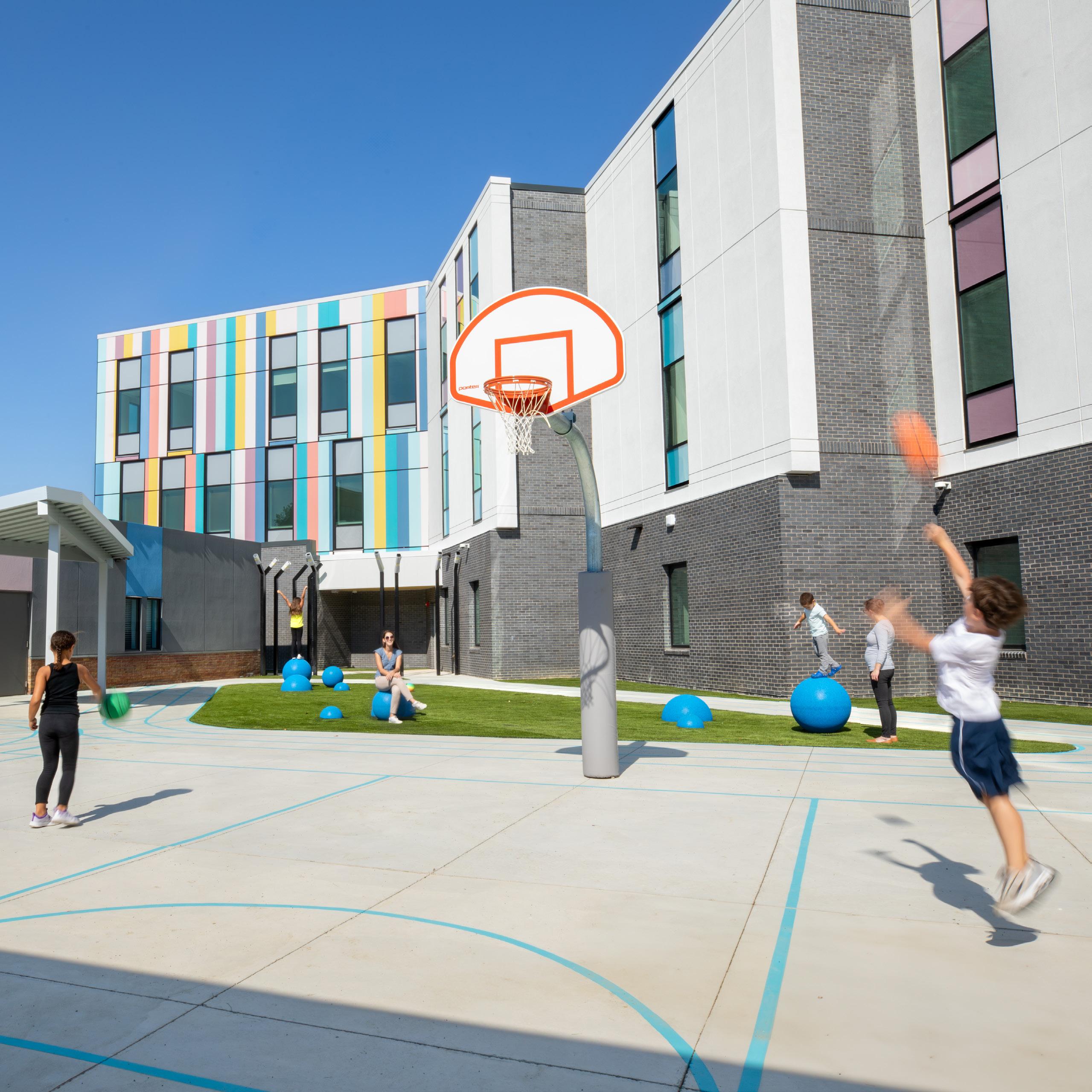
We have selected three recent IKM projects that represent our commitment to creating facilities that support the holistic wellbeing of patients and staff:
William Sharpe Psychiatric Hospital 50-Bed Addition
Southwood Children's Behavioral Healthcare 108-Bed Addition
AHN Forbes Regional Hospital ED Behavioral Health Suite
In the next pages, we will introduce six current challenges in designing successful behavioral health spaces. The above projects will illustrate examples of design strategies to address these principles:
Visibility
Staff Safety
Connection to Nature
Designing for Dignity
Security
Freedom of Choice
The risk of violence and self-harm is a major concern in behavioral health facilities. Architecture can serve as a tool to minimize that risk by creating spaces with higher visibility for staff supervision. Open nurse stations establish clear lines of sight between staff and patients, and blind spots are reduced by eliminating corners where patients can hide.
The leading risk factors for suicide attempts include depression, substance abuse, hopelessness, and a history of trauma.
One Attempt Made Every 26.2 Seconds
On Average 130 Suicides Per Day
1,204,575 Attempts Made Every Year
Right: The nurse work station at Forbes Hospital Emergency Department allows for direct views of all patients within each secure holding room as well as the milieu space.
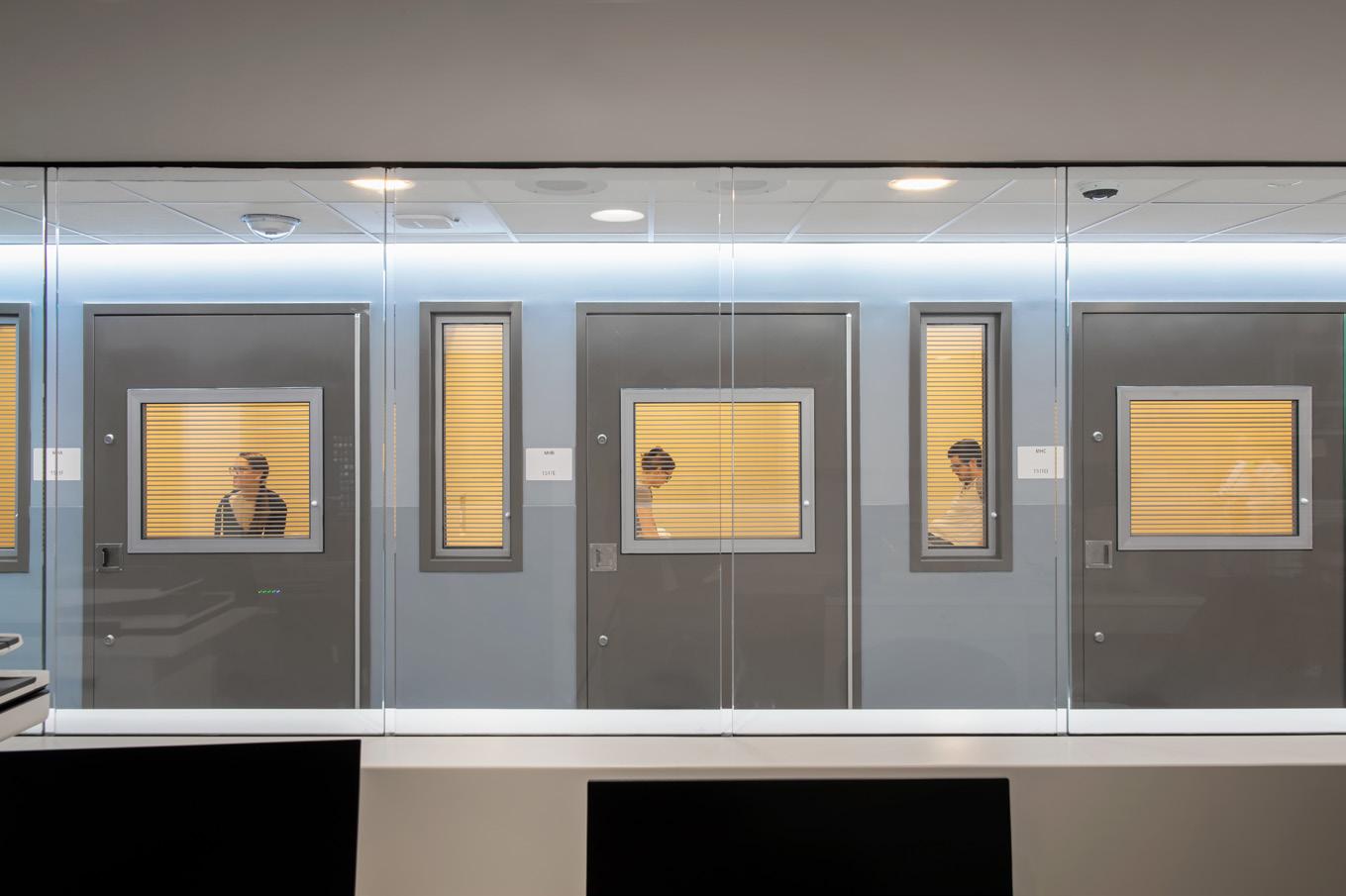
Staff Sight Lines
Courtyards / Green Space
Shared Patient Spaces
Staff Spaces
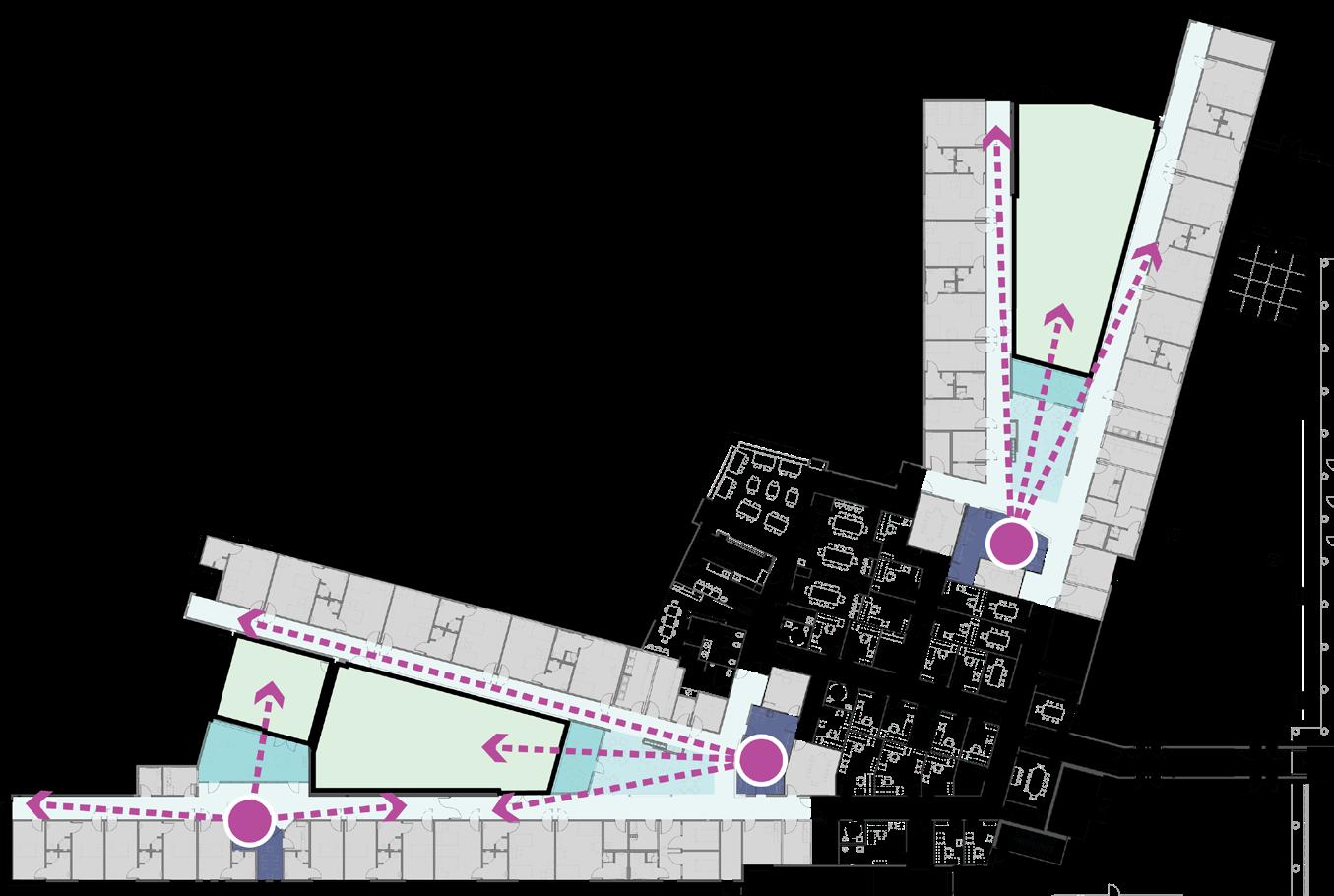
Left: William Sharpe Hospital is organized to allow for complete visual control down all single-loaded patient corridors, patient spaces and integral outdoor courtyard.
Below: Southwood Children's Behavioral Healthcare nurse station protrudes into the main circulation path to allow for unobstructed views of all patient spaces within the unit.
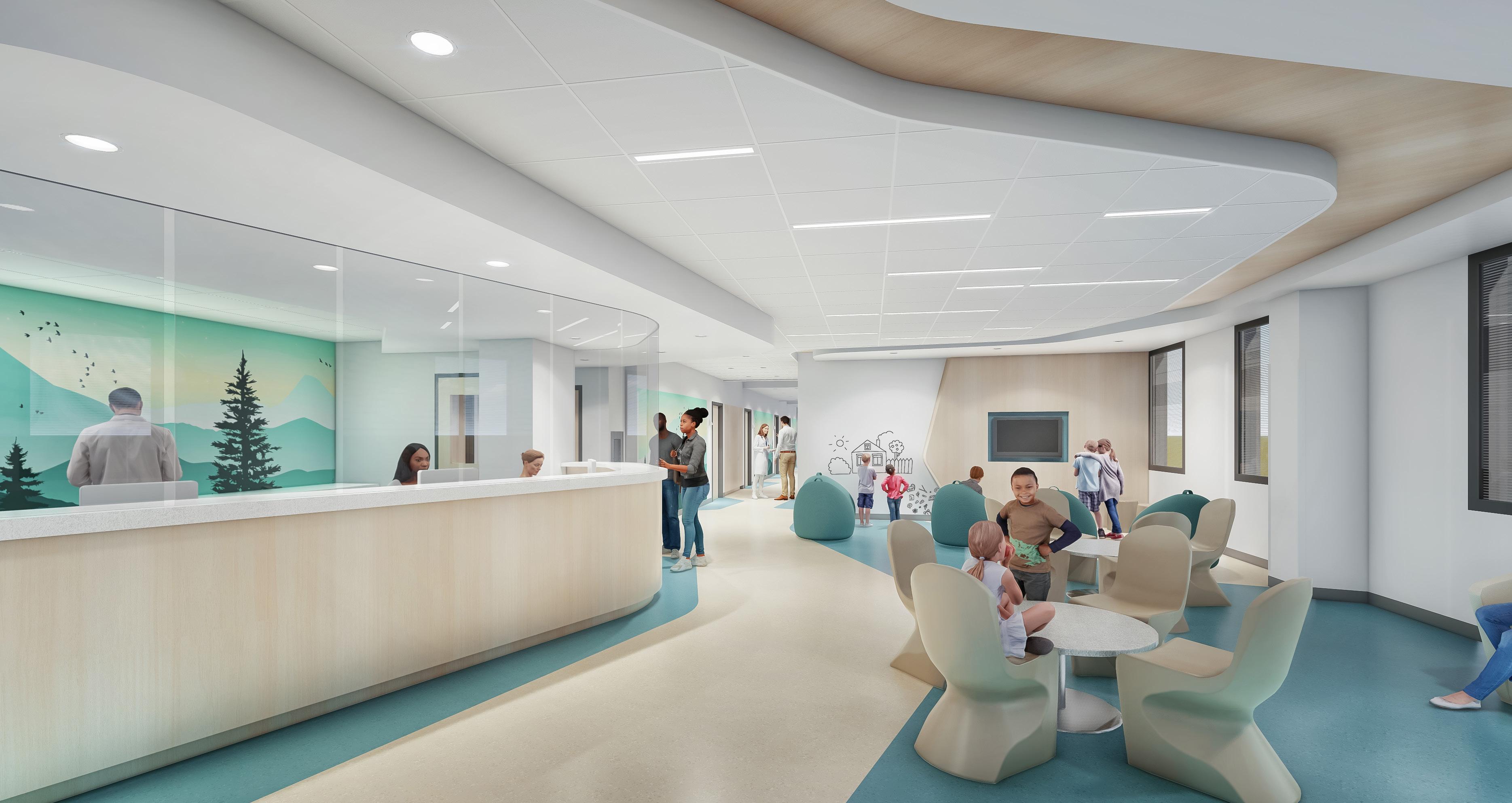
Staff retention impacts the quality of patient care, but it can be a challenge when staff shortages are widespread. It’s important to create an environment where staff feel safe and supported. By integrating accessible lounges, places of respite, and paths for safe retreat away from patients, facilities are more likely to recruit and retain committed staff members.
Inadequate supply of the ‘right’ behavioral health professionals to provide timely care to all who need it.
Projected 2030 Workforce
from the suite without moving through a patient area.

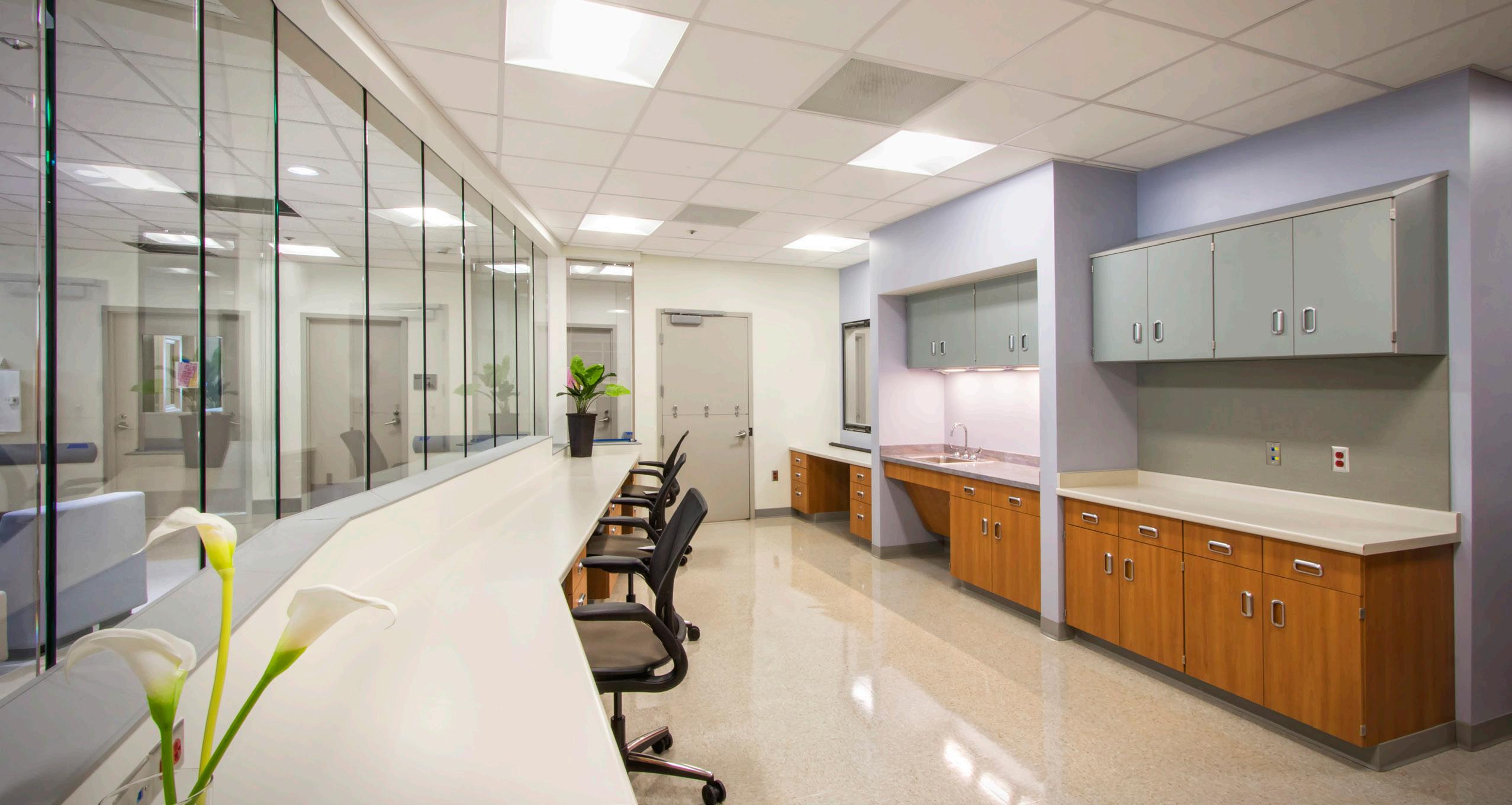

Shared Patient Spaces
Staff Spaces
Above: Separating staff from a forensic population, the nurse station at William Sharpe Hospital provides physical separation while still maintaining the ability to communicate with patients.
Left: Southwood Hospital's nurse station is centrally located to permit staff to easily access other staff-only amenities, such as lounge, respite room and offices.
Access to nature is proven to have a positive impact on all types of healthcare. Traditional behavioral health facilities have sacrificed nature to create fortress-like structures focused on restricting opportunities for elopement or harm. IKM designs incorporate elements known to help patients heal, such as supervised outdoor courtyards and large windows for natural light. Interior spaces can encourage relaxation with images of nature and lighting that mimics the circadian rhythm.
Vitamin D is made naturally in the body via UVB light and interacts with nearly every cell in the body.
Strengthens Bones & Muscles Boosts Immunity Reduces Inflammation Improves Heart Function
Right: A centrally located courtyard at William Sharpe Hospital is key to capturing daylight in patient areas that typically don't have access to direct light.
Improves Mood
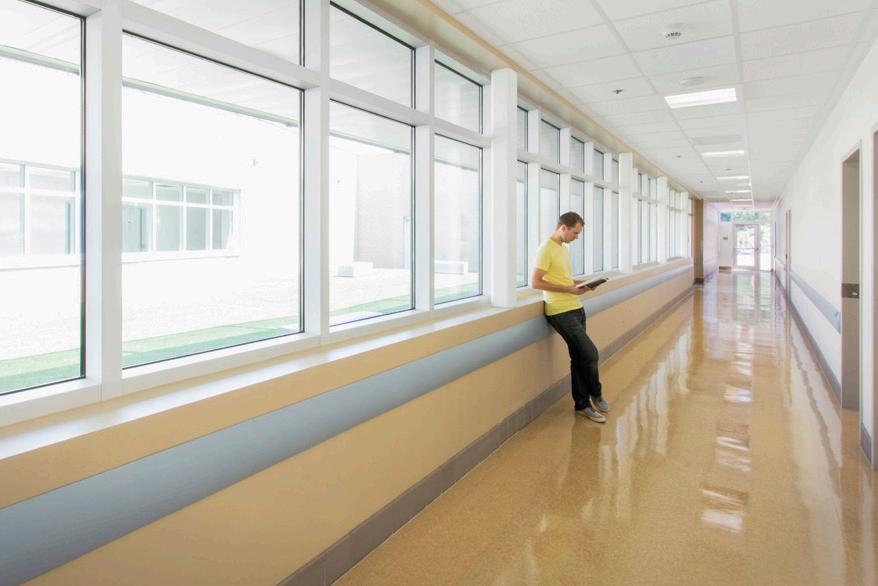
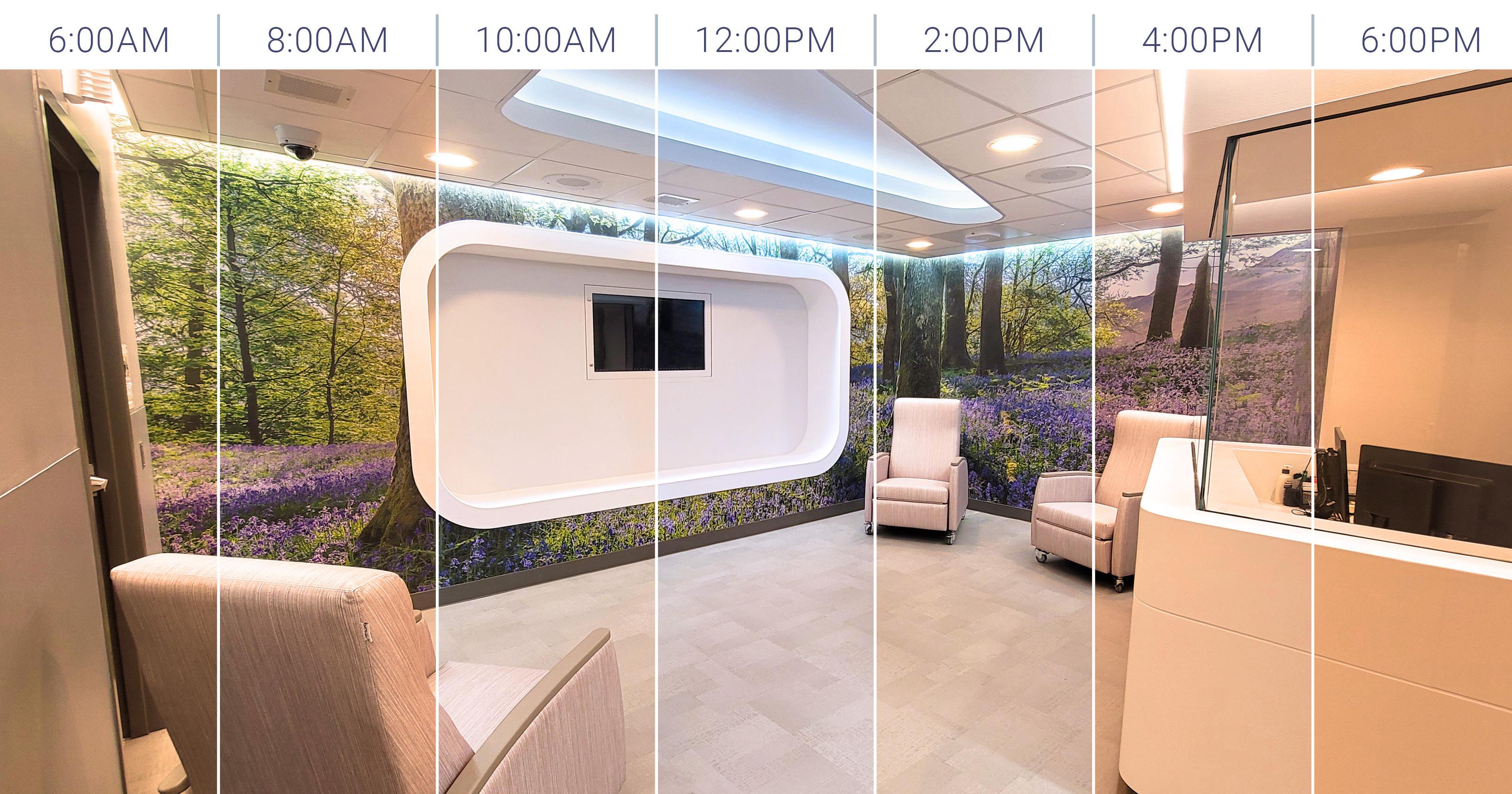

Above: Due to limited access to natural daylight, the light fixtures in Forbes Hospital Emergency Department mimic daylight's changing color to maintain patients' circadian rhythms.
Left: Southwood Children's Behavioral Healthcare's patient corridors have custom designed wall protection graphics depicting a calming mountainous woodland.
Entering an unfamiliar behavioral health facility can be a stressful experience. By understanding the patient perspective, we can create spaces that give them dignity by addressing their emotional needs. Some patients may sit in the Emergency Department suite overnight, so reclining chairs and indirect lighting allows them the chance to rest. For long-term stays, homelike private rooms offer solace and elements of personalization give patients ownership of their space.
A home-like environment has been associated with enhanced emotional and intellectual well-being.
Comfortable
Welcoming
Perceived Control
Lighting Design Choice Calming
Featured Incorporation of Dignity in Design
Appropriate Acoustics
Access to Daylight
Ventilation
Visual Stimuli
Home-like Feel
Right: The unique wall-washing and cove lighting in Forbes Hospital Emergency Department was chosen to eliminate harsh downlights above patients utilizing recliners during their stay.


Left: The bedrooms at William Sharpe Hospital are designed so each patient has a space that feels their own.
Below: The exterior of Southwood Children's Behavioral Healthcare was designed to feel playful and inviting for children of all ages and have a calming effect on parents who may be experiencing anxiety when leaving their child in the facility's care.

Protecting patients and staff is the foundation of behavioral health design. Codes enforce specific requirements and needs vary from space to space depending on risk of harm. IKM has implemented intricate security measures in every facility we’ve designed. Elements to consider include security cameras, anti-elopement strategies, and interior finishes including door hardware, furniture, flooring, and more.
Environmental Safety Risk Assessments evaluate necessary safety and security measures for a wide spectrum of spaces.
Right: Due to the child and adolescent patient population at Southwood Children's Behavioral healthcare, each space was designed to meet the required security levels.
Opportunity for Self-Harm
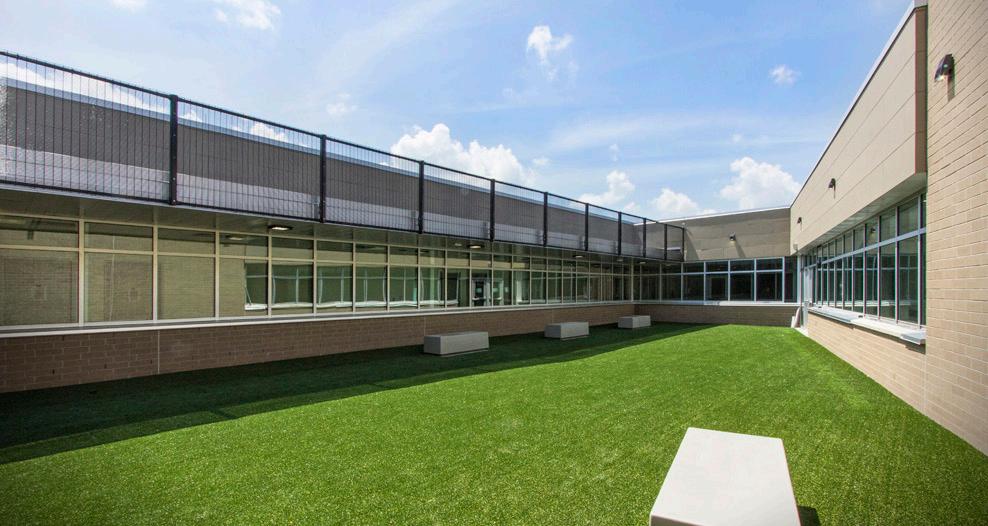
Above: William Sharpe Hospital's outdoor courtyard utilizes an anti-climb fence to prevent possible patient elopement.
Left: Security cameras are located throughout Southwood Children's Behavioral Healthcare to provide full coverage of both interior and exterior patient areas.
One of the first compromises a behavioral health patient experiences is lack of freedom to make their own decisions, which can contribute to anxiety and violence within a facility. Some of that freedom can be restored through strategic design. Varied seating arrangements allow social spaces to accommodate patients’ intended uses, while enclosing outdoor space within the nursing unit gives patients the freedom to access nature under the surveillance of the nurse station.
Patient behavior and time spent doing that type of activity varies by room type.
Right: Despite limited square footage, the Forbes Hospital Emergency Department provides flexible seating options for patients to choose the level of social interaction they desire.
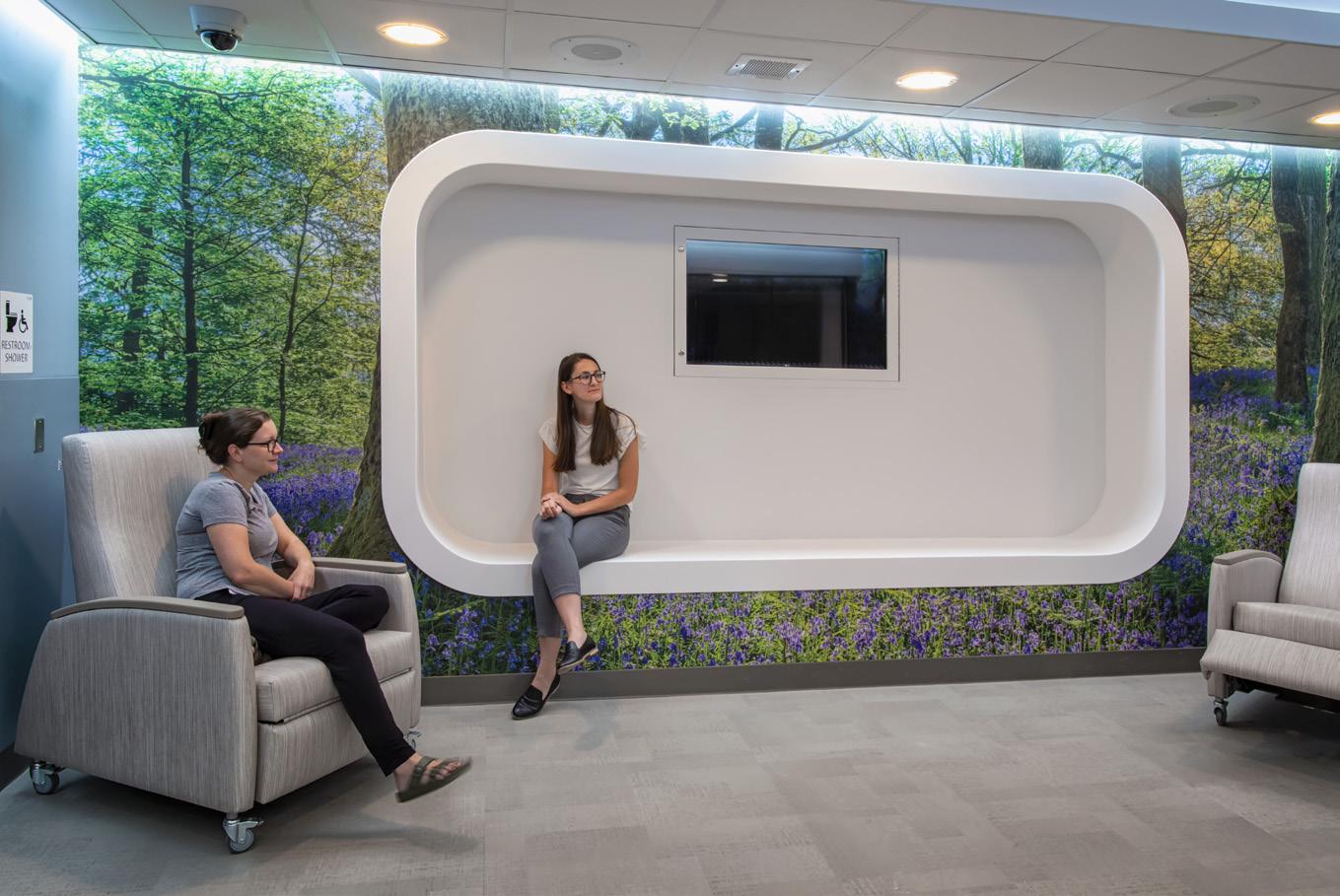
Left: William Sharpe Hospital's patient areas are designed so patients can move freely between a variety of interior and exterior spaces.
Below: Patients at Southwood Children's Behavioral Healthcare have free access to noisier play areas and quieter nooks throughout the day.
Space Shared Patient Spaces Staff Spaces Patient Movement Staff Movement
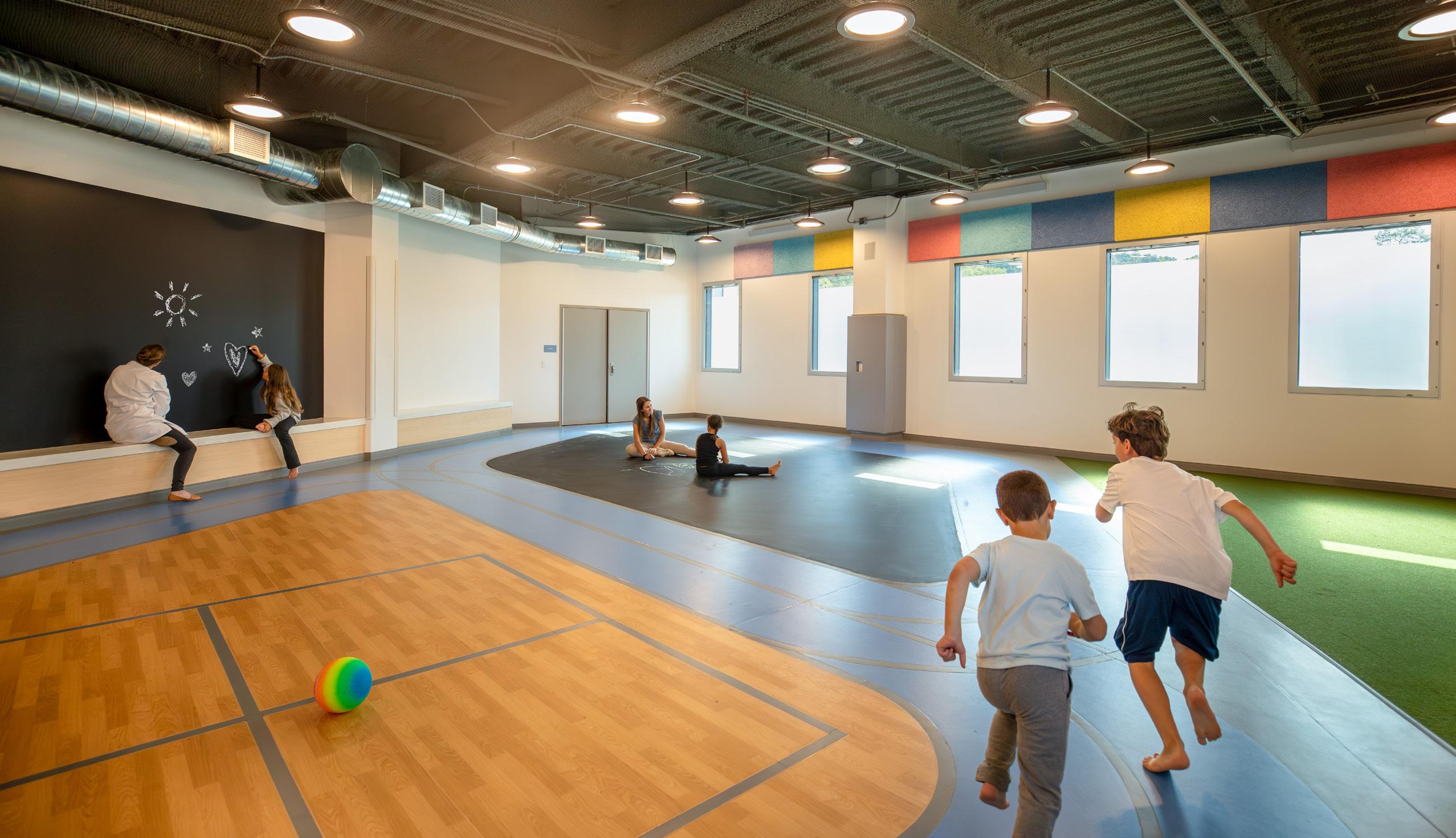
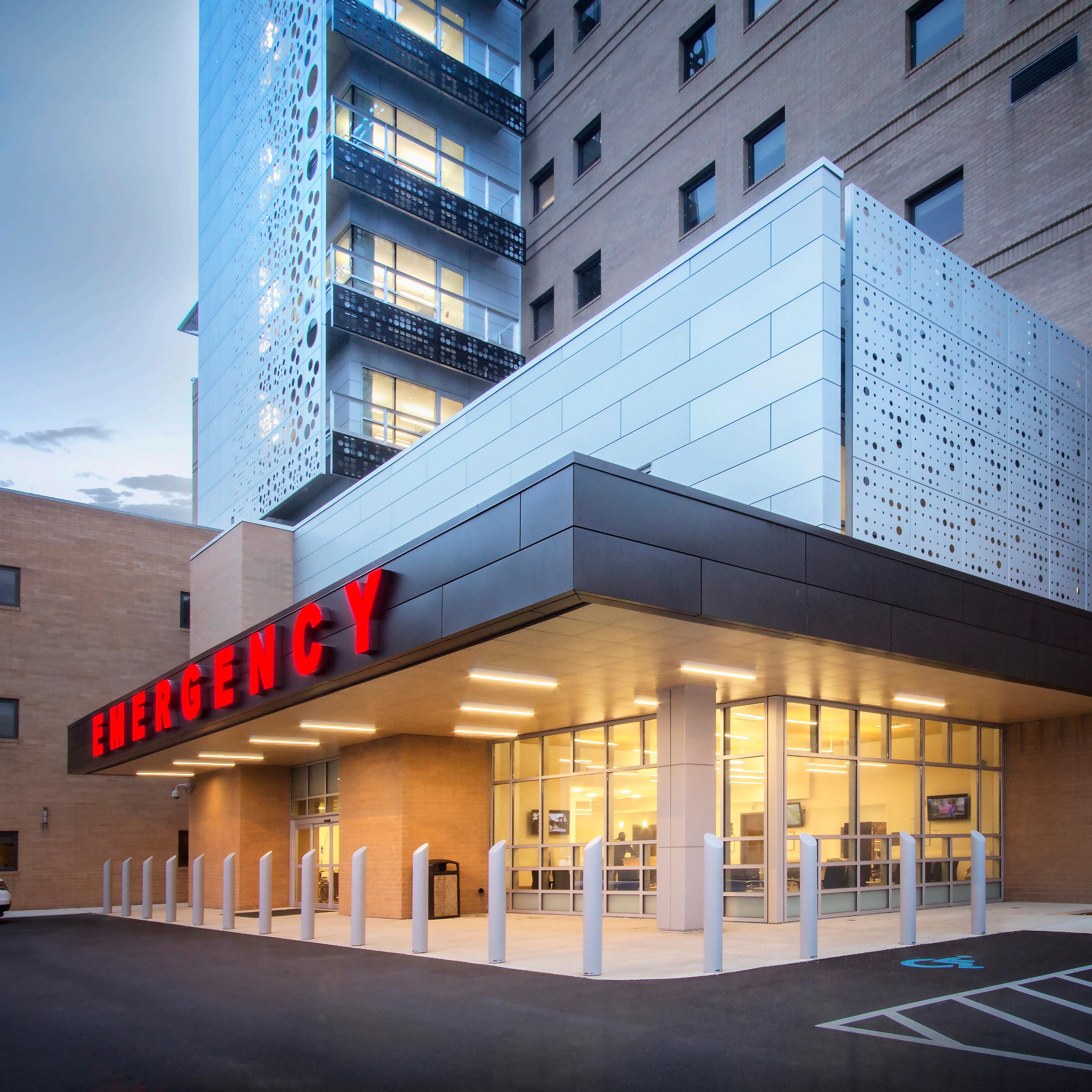
At IKM, data is integral to our process. We consult up-to-date resources to inform our behavioral health designs, as well as to evaluate where the field is heading next. As a forward-thinking firm, we create environments with the foresight and flexibility to serve not just the current patient population, but those seeking care for years to come. Continuous learning is infused in our practices, which evolve alongside cutting-edge research. We prioritize forming a meaningful partnership with each client and sharing our expertise to make collaborative, informed decisions and deliver the solution best suited to the specific project and users. On the next pages, we will break down our insight on the latest areas of growth based on our analysis of recent data and project experience.
The settings in which behavioral healthcare is delivered are vast. In order to support demand, most of these facility and space types will grow and evolve as we learn more about the unique and diverse needs of this patient population. IKM has identified five key areas of immediate growth that will impact behavioral health.
Psychiatric Inpatient
Overnight Stay
Less than 30 day stay
Provides continuous Support
Psychiatric Residential
Longer-term care
Usually 90 day stay
Less institutionalized feel
Psychiatric Outpatient
No overnight stay
Tailored to treatment plan
Provides increased flexibility
Workplace Environments
Frequent and routine
Full or part-time employment
Wellness-oriented culture
Educational Environments
Frequent and routine
School and after-school hours
Active learning and development
Units in General Hospitals
Drug and Alcohol Detoxification
Drug and Alcohol Rehabilitation
Nursing Home
Other Psychiatric Hospitals
Other Psychiatric Residential Center
Clinics in General Hospitals Private Practice
Community Mental Health Programs
Workout Space
Veterans Affairs
Other
Respite Rooms
Quiet Rooms
Therapy Rooms
Counselor Rooms
Outpatient Clinics
Informal
Breakout Spaces
Dedicated Quiet Workstations
Classroom for Multiple Learning Modalities
Life Skills Rooms
Small Group Learning Rooms
1 in
Emergency Department visits is associated with a behavioral health issue.
In a population with increasing behavioral health needs and a lack of facilities to treat them, many behavioral patients turn to Emergency Departments for care. It is increasingly important for facilities to adapt their EDs to adequately care for behavioral patients, by creating designated behavioral suites or “swing rooms” that can flex to accommodate a variety of patient types.
Our communities are also being equipped to better serve the growing behavioral health need. Research shows that community-based healthcare helps to address disparities, like socioeconomic factors, by personalizing services and focusing resources on the specific needs of a demographic area.
160M
This is the amount of money allocated for mental health services in a recent bipartisan bill by congress. These monies will fund the expansion of school-based mental health services, further blending the sectors of education and healthcare to provide resources and spaces that are not yet widely available in educational settings.
$12.3B
60%
Live in a designated psychiatrist shortage area. Of Psychiatrists report having no openings for new patients.
Individuals with a Behavioral diagnosis account for:
27%
57% of the population of health spending
The stigma surrounding behavioral health prevents patients from seeking help and discourages potential staff from entering the field. Workers that do pursue behavioral health jobs often encounter low reimbursement rates that damage the incentive to stay. To provide better care and reduce total cost, the industry must start by improving care for the populations experiencing the greatest disparities and worst outcomes.
With growing need and a shrinking workforce, supply and demand has an inflated impact on behavioral healthcare. Telemedicine continues to see rapid growth as it allows caregivers to reach more patients from a broader demographic. However, unchecked use of telemedicine has the potential to exacerbate inequities by catering to low-acuity, higher income users and separating from the patient continuum of care.

IKM’s experience with behavioral health projects spans the full range of care facilities and environments. We have designed for the complete patient journey, from Emergency Department suites, to inpatient and residential long-term care, to outpatient centers. Our healthcare expertise also informs our work in the education and workplace sectors. Behavioral health data is constantly evolving, and our designs reflect that. We are committed to continuous progress and to creating the best facilities for our clients with the most up-to-date resources available.
Inpatient
Chestnut Ridge Psychiatric Hospital, WVU Medicine, Renovation and Addition
Forbes Hospital 40 Bed Behavioral Health Inpatient Unit Renovation
Forbes Hospital Emergency Department Behavioral Health Unit
Indiana Regional Medical Center Geriatric Behavioral Health Inpatient Unit
Lakewood 40 Bed Inpatient Psychiatric Hospital
Southwood 70 Bed Child and Adolescent Psychiatric Hospital Original Building
Southwood 108 Bed New Child and Adolescent Psychiatric Hospital on Existing Campus
Southwood Child and Adolescent Psychiatric Hospital Inpatient Unit Renovation
UPMC Shenango Psychiatric Inpatient Unit Renovation
UPMC Western Psychiatric Institute and Clinic, Multiple Projects
Veteran Affairs Clarksburg, WV 10 Bed Inpatient Unit, Adaptive Reuse of Administration Area
Veteran Affairs Oakland PA Emergency Department Behavioral Health Unit
West Penn Hospital Behavioral Health Inpatient Unit Renovation
William Sharpe 50 Bed Behavioral Health Inpatient Addition
WVU Medicine Hospital Emergency Department Behavioral Health Unit
Residential
Southwood Child and Adolescent Psychiatric Hospital Residential Unit Adaptive Reuse of Administration Area
Outpatient
Penn State Health Lancaster Pediatric Behavioral Health Outpatient Care Center
West Penn Hospital Postpartum Depression Outpatient Care Center
Workplace
Confidential Financial Client Pittsburgh Commercial Office Building Restack
IKM Pittsburgh Office
Confidential Financial Client - Charlotte Tenant Fit-out
Confidential Financial Client - Pittsburgh Tenant Fit-out
Education
Avonworth School District Middle and High School
Butler High School Library and Administration Renovation
Chartiers Valley Intermediate and High School
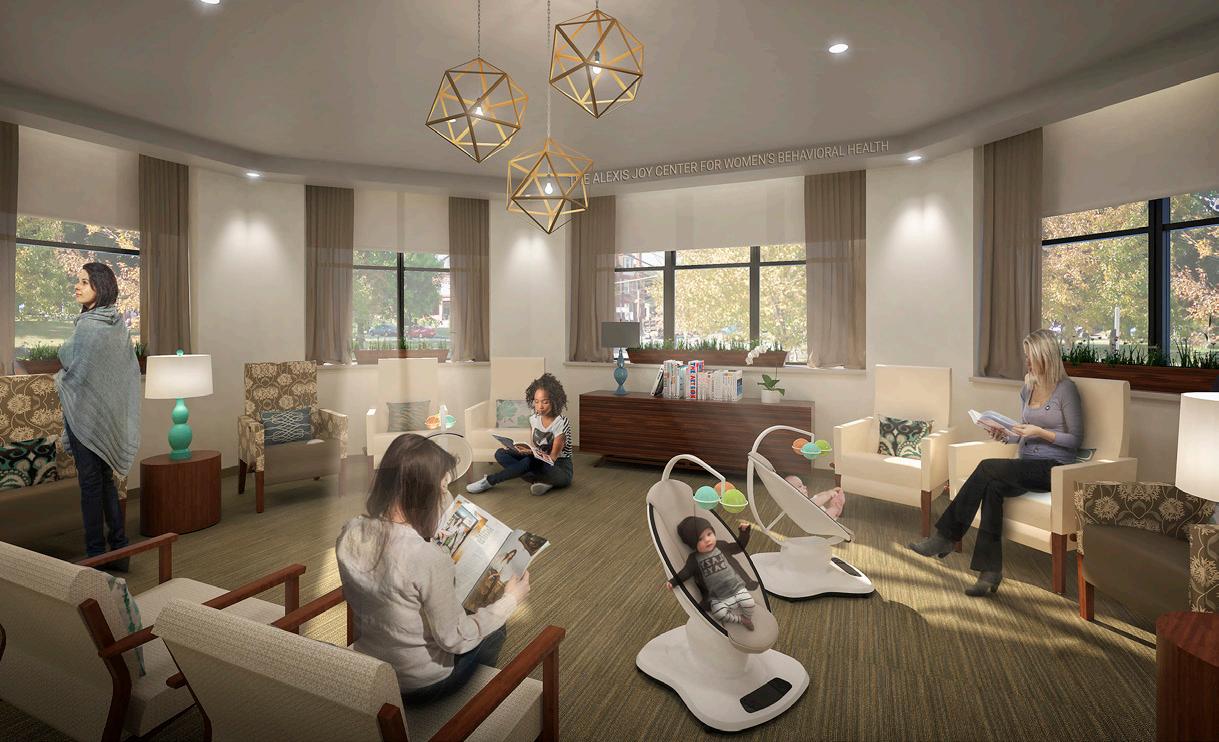

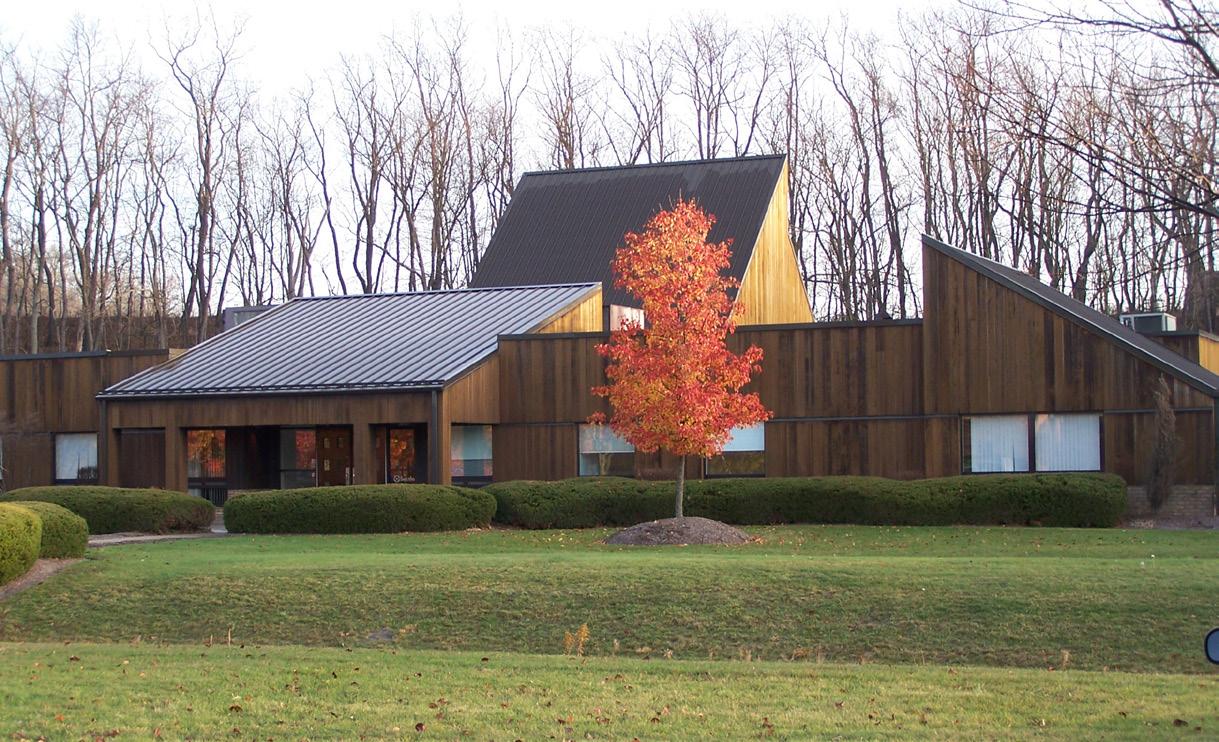
This 7,300 square foot outpatient care center serves women who are experiencing behavioral health challenges during pregnancy, postpartum, and beyond. A group therapy room with windows overlooking the adjacent park is the central focus of this specialized facility, offering a safe and comfortable space for moms to participate in bonding and stress relief activities.
The fourth floor of the VA Medical Center in Clarksburg, WV, was renovated to house a new ten-bed behavioral health unit. The Day Room, Group Room, and Dining Room have securable cabinetry to store technology and materials for patient activities. Staff spaces include a secured nurse station, conference room, and lounge. The unit is considered an “unlocked” space due to the integration of patient monitoring systems with door hardware.
This 2,000 square foot renovation transforms administrative offices into residential units for the Sexually Maladaptive Behaviors Program at the IKM-designed Southwood Psychiatric Hospital. Adding sixteen total beds, the patient rooms are split into two units to better serve patients and support staff. Appropriate finishes and security measures were implemented for safety, including alarms to alert staff when patients leave their beds at night
